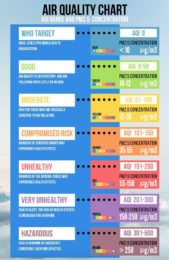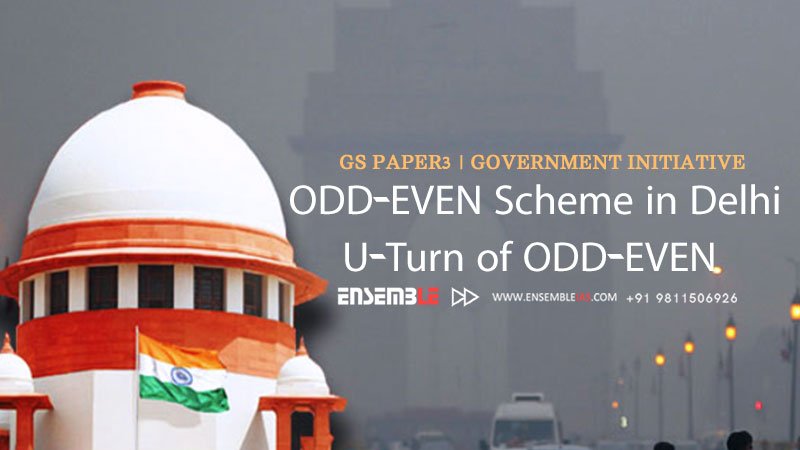ODD-EVEN Scheme in Delhi U-Turn of ODD-EVEN scheme in Delhi
Why in the News?
- Delhi Environment Minister Gopal Rai launched an odd-even program for four-wheelers on November 6.
- The implementation of the odd-even rule was announced because of bad air quality.
- The trial of the odd-even scheme is starting from November 13 to November 20.
- Given the increase in pollution, this would be the fourth time the odd-even restricting method will be implemented in the city.
What is the odd-even rule?
- The term “odd-even scheme” usually refers to a traffic control policy established by the Delhi government in 2016.
- It is a traffic rationing system where vehicles can travel as per their number plates.
- Vehicles with license plates ending in odd numbers are permitted to operate on certain days. In contrast, vehicles with license plates ending in even numbers are permitted to operate on other days.
Purpose
- To reduce traffic & road congestion.
- To reduce air pollution and enhance air quality
- To promote public transport
- To increase awareness about environmental pollution.
Origin of Odd-Even Rule
- The USA established it in 1979 for the first time. When hurricane Sandy hit the USA, to cover the shortage of Gasoline, the USA applied it a second time in 2012.
- 2. Beijing also started in 2008 during the Olympic games.
- China, Mexico, and Italy also applied the odd-even rule in their country.
Vehicles exemption
Only emergency and police vehicles, two-wheelers, and women-driven cars were spared from the system when it was first adopted in 2016. During the second implementation (November 2019), two-wheelers and electric cars were exempt, as were medical emergency vehicles and those transporting schoolchildren in uniform. Vehicles transporting VIPs, women alone, and people with disabilities were also excused.
Studies on Odd-even scheme
The Energy Policy Institute at the University of Chicago and Evidence for Policy Design researched to assess the impact of the odd-even system, which was introduced in 2016. It was discovered that during the hours the initiative was in effect in January of that year, Delhi experienced a 14-16% reduction in PM2.5 levels. However, when the plan was reinstated in April of that year, there was no reduction in pollution.
The IIT-Delhi researchers also conducted a study in India, and they discovered that car rationing on Delhi’s roadways reduced air pollution by only two to three per cent when the policy was implemented initially in 2016.
The link to join the course : Online Courses

Air-Quality Index (AQI)
- The Air Quality Index (AQI) is a standardised numerical scale for communicating air quality, analysing air quality levels, and evaluating potential health hazards.
- Environment Minister Shri Prakash Javadekar launched the National Air Quality Index (AQI) in India on September 17, 2014, in New Delhi as part of the Swachh Bharat Abhiyan.
- AQI was designed with an outline with One Number-One Colour – One Description” to understand commoners.
- In the current situation, Delhi’s air quality has decreased, and On Sunday, Delhi’s air quality is in Stage IV of the Graded Response Action Plan.
- Chief Minister Arvind Kejriwal held a high-level meeting with cabinet members, Delhi Education Minister Atishi and her colleagues Saurabh Bhardwaj and Kailash Gahlot.
- As a result of this meeting, Environment Minister Mr Rai announced the Odd-Even scheme, school closures for primary to 9th class, work from home for 50% of staff, and a restriction on construction-related activities, as well as a ban on truck entry into Delhi (save for those involved with vital services) and building work, including public projects.
What is the Graded Response Action Plan?
GRAP is a series of emergency measures that kick in to prevent further degradation of air quality in the Delhi-NCR region once it reaches a specific threshold. GRAP is divided into four stages: stage 1 requires an AQI between 201 and 300, stage 2 requires an AQI between 301 and 400, stage III requires an AQI between 401 and 450, and stage IV requires an AQI between 450 and 500.
This year, 2023, the Centre also issued a call to implement all actions outlined in Stage IV of the Graded Response Action Plan (GRAP) – Severe Air Quality (Delhi’s AQI > 450), with immediate effect throughout the whole national capital region (NCR).
Conclusion: The odd-even scheme will improve air quality; however, instead of relying on only one solution, authorities should try to find more effective solutions.
- More electric vehicles and infrastructures for EV transports.
- More accessible public transport.
- Banned stubble burning.
Best Online Coaching for Civil Service_IAS_ UPSC_IFS_IPS
Free Study Material ENSEMBLE IAS ACADEMY | Call +91 98115 06926
Visit us:- https://ensembleias.com/ | Online Store: https://online.ensemble.net.in/
#increase_pollution #Oddevenrule #airquality #civil_services_study #ensemble_ias_academy #geography_optional #k_siddharthasir #ias #upsc_exam #civilservices #upsc_motivation #upsc_aspirants #trendsingeography #arvindCMdelhi #severeairquality #AQI #DelhiNCR




